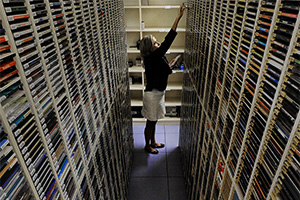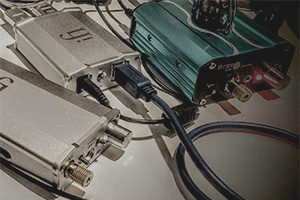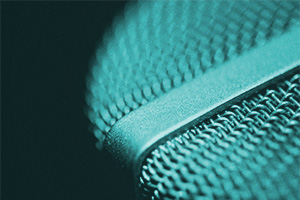Have you used an Android or Apple smartphone recently? Beneath the big screens beat very similar hearts: the phones’ processors are based on the big.LITTLE designs by ARM. But they beat in very different ways. On paper, Apple’s processors aren’t as powerful as rivals’ ones. In the real world and in tests, they destroy the competition. That’s because Apple got stuck into the silicon. ARM designs systems for everyone. Apple took ARM’s design and optimised it to make it ideal for Apple.
We know exactly how that feels. We do it with our DACs.
Why bespoke is better
To some manufacturers a DAC—digital to analogue converter—is just an off-the-shelf chip stuck to a circuit board. The chip is a piece of silicon with input and output pins, and a specification sheet that tells the designer where on the chip to send the digital data, and which pin the analogue music signal will come out.
A cheap USB DAC will do little beyond this, and will suffer from data loss and distortion as a consequence. It is optimised for low, low cost and the smallest possible size.
The more costly USB DACs mitigate these issues by mastering the clock from the DAC chip, instead of being driven by the computer. But fundamentally, the manufacturer has used an off-the-shelf solution with a twist.
The easiest thing for Linn to do would be to take and test a whole bunch of DACs, find the one that sounded best and make a few modifications. But we don’t take the easy road when building the best possible musical source: just like the original LP12, we expect our digital sources to improve the sound of any hi-fi system. And that means taking the DAC down to its individual building blocks and redesigning it to meet our very strict requirements.
Easy? Nope. Worth it? We think your ears will say yes.
Everything starts with a C
For us, being able to customise the DAC is crucial, because we think the C in DAC should stand for “creation”. To Linn’s engineers, a DAC isn’t a mere portal for musical information to pass through, but something that actually creates the analogue signal that’s the very source of your music system.
Think of it as the needle on the groove of the record: the relationship between the platter, tonearm and cartridge determines whether information is retrieved, or lost; exactly the same is true with DACs. You only get one shot at creating an analogue signal from the digital data, and if you lose any detail it’s gone forever. You can’t improve something that’s no longer there.
Doing things the hard way
When we designed our latest DAC architecture, Katalyst, we didn’t just stick with the defaults. We wanted access to everything, to have an unprecedented level of control over the critical elements that lie at the heart of the analogue signal’s creation. We wanted to reengineer the DAC to eliminate distortion and create the most precise signal possible.
We improved the data optimisation to perform much more accurate data signal conversion, designed a superior master clock to deliver greater timing accuracy, implemented independent power supplies to eliminate feedback from individual processes, created a new ultra-low distortion output driver to reduce output noise and degradation and produced an all-new, high stability input reference level.
In plain English that means we eliminate even the most miniscule variations in the reference level to ensure our most precise analogue musical signal ever. If you’re interested in the science, there’s a great guide to it on our Katalyst page.
The halo effect
Katalyst is our fourth generation DAC design. Our first, Numerik, was back in 1991 and was followed by the CD12 in 1998 and the Klimax DS in 2007. With each generation we’ve pushed the limits of the technology to deliver the best analogue signal possible, and as technology has improved so have the possibilities.
With Katalyst, we took a DAC chip designed for a wide range of uses and personalised it to make it perfect for Linn systems and Linn customers. And the original chip designer, AKM, couldn’t be happier: we’re the AMG to their Mercedes-Benz, taking a standard design and completely rebuilding it to make something truly extraordinary. By showing other manufacturers the possibilities of AKM’s architecture when it’s pushed to the very extremes of performance, we’ve blazed a trail that AKM hopes other firms may follow.
That’s great, but of course what really matters to us is the opinion of our customers. And they tell us that our Klimax DS and Klimax DSM network music players with Katalyst make music more tangible, more tuneful, more dramatic and altogether more engaging. And because we always engineer our products with the future in mind, existing Klimax DS or Klimax DSM owners can of course upgrade to Katalyst without faff or fuss, even on systems nearly a decade old.
Upgrades to other Linn products have come hot on their heels too. It’s a huge upgrade and involved a colossal effort, but when you hear the difference you’ll understand why we did it.
Easy? Nope. Worth it? Hell yes. But don't just take our word for it, book a demonstration and experience it for yourself.



